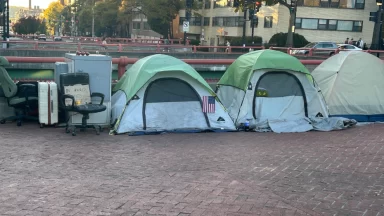
When Berenice Abbott photographed 857 Riverside Drive near 160th Street in 1937, the small, wood-frame house in today’s Washington Heights was a charming relic from New York’s antebellum era.
Built in 1851 in the Italianate style, it boasted clapboard siding, wood shutters, a wraparound porch with decorative trim, and a roof topped with an octagon-shaped cupola. The cupola must have allowed for gorgeous views of the Hudson River in the unspoiled countryside of uptown Manhattan.
Today, number 857 retains little of its original beauty. At some point in the 20th century, the cupola was lopped off, the porch ripped away, and much of the clapboard siding removed, replaced by faux stone. The boxy shape of the house still exists, wedged between rowhouses.
But the renovation to the house’s facade couldn’t erase its noteworthy history: number 857 was owned by two New York abolitionists and may have been part of the Underground Railroad.
Dennis Harris, an English-born sugar refinery owner and ardent anti-slavery proponent, lived here between 1852 and 1854, according to a report by the Upper Riverside Residents Alliance, via a New York Times article from January by John Freeman Gill.
Harris originally owned a sugar refinery in today’s Tribeca, and one New York paper contains an 1885 story recalling how Harris helped hide a fugitive slave there and assisted in getting the man to Canada.
When that refinery burned down, Harris rebuilt it steps from number 857, at the foot of 160th Street and the Hudson River. He also began running a steamboat from Lower Manhattan to 160th Street and on to Poughkeepsie, which historians in the New York Times article suggest could have been a way to ferry enslaved people up the Hudson and closer to Canada.
Harris, who “gave impassioned antislavery sermons and held abolitionist gatherings” at the Wesleyan Methodist Chapel on King Street, per the New York Times piece, then sold the house to his friend and fellow abolitionist, Judge John Newhouse.
The Riverside Drive house certainly wouldn’t be the first in New York to have ties to the abolitionist movement. While the city itself was pro-slavery (largely because so many businesses depended on trade with the South), an impassioned abolitionist community thrived before the Civil War. Underground railroad stops are thought to have existed at 36 Lispenard Street, 339 West 29th Street, and 227 Duffield Street in Brooklyn.
Source: The abolitionist history of a little wood house on Riverside Drive



Recent Comments